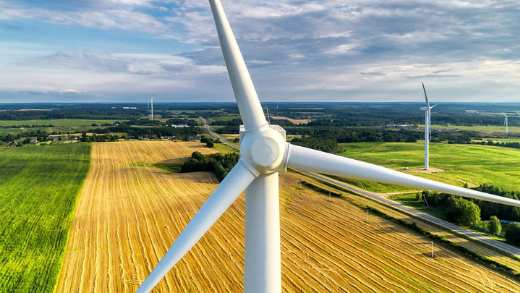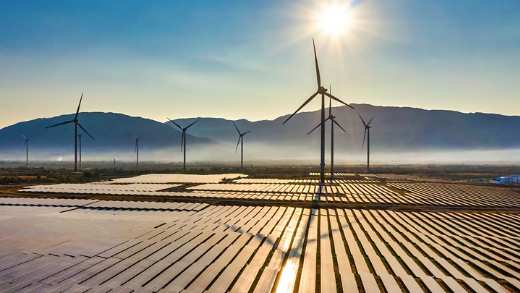Read this article to understand:
- The importance of batteries in the fight against climate change
- The resource constraints facing the industry
- Why governments are trying to boost domestic industries
In 1991, Sony commercialised the world’s first lithium-ion battery, which it had developed with Japanese chemicals group Asahi Kasei. The dramatic increase in energy density offered by the battery made it far more practical to use electronic devices, such as Sony’s video cameras, outdoors.
Within just a few years, almost all video cameras were using lithium-ion batteries. Over the course of the next decade, this pattern would repeat itself, with laptops, mobile phones and power tools all making that same switch.
By 2004, the rapid development of battery technology had led US automaker Tesla Motors to begin developing the Tesla Roadster, the world’s first mass-produced, all-electric car. First delivered to customers four years later, it was able to travel more than 320 kilometres (200 miles) on a single charge of its lithium-ion battery.
Four years after that and US utility Portland General Electric was demonstrating how a lithium-ion battery could be used to store electricity and thereby better integrate variable renewable energy sources like solar and wind into electrical grids.
With power generation and road transport accounting for around 27 per cent1 and 11 per cent2 respectively of global carbon dioxide emissions in 2021, it is clear batteries have a vital role to play as the world attempts to tackle climate change.
Battery demand from vehicle manufacturers is expected to grow by around 30 per cent a year up to 2030, according to a recent report from the consultancy McKinsey & Company. It predicted the battery value chain would increase by as much as ten times between 2020 and 2030, increasing annual revenue by as much as $410 billion.3
While set to remain a far smaller market, utility-scale energy storage is growing exponentially too. It attracted record investment of $5.2 billion in 2021, a fivefold increase in the space of just four years. BloombergNEF predicts the market will grow 15-fold by 2030.4
Basic resource challenges
Such rapid growth is certain to throw up investment opportunities. However, for electric batteries to fulfil their potential, several challenges need to be overcome.
Sourcing the various vital raw materials in sufficient quantities threatens to be one of the biggest challenges
Sourcing the various vital raw materials in sufficient quantities threatens to be one of the biggest. Growth in demand from battery makers is already putting pressure on supply chains for various materials, including lithium carbonate, the price of which more than doubled in 2022 as supply struggled to keep pace with surging demand.
Since battery manufacturers look set to face ever stiffer competition for scarce resources from other industries in the coming years, companies may need to develop a robust strategy for procuring raw materials to avoid becoming a hostage to fortune.
Complicating matters, extraction of the most important materials needed to produce electric batteries is concentrated in a handful of countries. In an increasingly fractious world, that threatens to be problematic. Nickel prices surged in the spring of 2022 after Russia, one of the world’s biggest producers, invaded Ukraine.
Figure 1: Where clean energy metals are mined - production of key resources is highly concentrated
Source: IEA. Data as of November 9, 20226
As for cobalt, which is used in one of the two most common forms of battery, around two thirds of global production comes from the Democratic Republic of the Congo. China has in recent years snapped up some of the African nation’s biggest mines.
In June 2021, the US government warned China might use its growing dominance of cobalt supplies to disrupt the American push toward electric vehicles by squeezing out US manufacturers. In response, it is reportedly pressing allies, including Australia and Canada, for access to their cobalt.7
Chinese dominance
While China is an important player in the extraction of crucial raw materials, it is dominant when it comes to turning them into usable materials. In 2019, it processed 65 per cent of the world’s cobalt, 58 per cent of its lithium, 35 per cent of the nickel produced and controlled virtually all the world’s supply of rare earths with an 87 per cent share.
Figure 2: China dominates processing and refining of key metals
Source: IEA. Data as of November 9, 20228
This is raising concern in the West that China could corner the market for the metals needed to power the ongoing growth of the electric battery industry. In April, the head of Tesla, Elon Musk, tweeted the automaker may get into the mining and refining business directly and at scale.9
However, others believe worries over the long-term security of supplies are overdone, partly since rising prices are likely to spur a shift to different technologies, as has happened this year.
Lithium-ion batteries mainly fall into one of three main types: NMC, NMA, and LFP
Lithium-ion batteries mainly fall into one of three main types, the difference being the materials the cathode is constructed from: NMC batteries have a cathode made from nickel, manganese and cobalt; NMA’s cathode is made from nickel, manganese and aluminium; while LFP’s is made from lithium, iron and phosphate.
Despite longstanding concerns over their safety, due to the risk of fires caused by thermal runaway, NMC and NMA batteries had until recently appeared to have an advantage owing to their superior energy density. That made them the technology of choice for many car manufacturers, especially at the top end of ranges, even if LFP batteries have historically been dominant in China.
However, with iron and phosphate relatively abundant, the competitiveness of LFP technology has improved since the start of 2020 as the price of cobalt and other materials needed to make NMC and NMA batteries soared. At the same time, manufacturers have found ways to cram more energy density into LFP batteries.
Swinging pendulum
“These factors have swung the pendulum in favour of LFP technology, at least for the time being,” says Jonathan Toub, global equities portfolio manager at Aviva Investors.
Companies, based mainly outside China, that had previously focused on NMC and NMA technologies are contemplating rolling out LFP batteries just to be able to provide their customers a choice, he adds.
But while the need to try to get a low-cost solution to be competitive in the marketplace has caused some car manufacturers to switch battery chemistry, it is unlikely to mark a decisive shift in LFP technology’s favour.
The big carmakers ultimately want a level of performance at a particular price point
“The big carmakers are fairly chemistry agnostic. They don't really care whether it's LFP or NCA or NCM, and are pressing for batteries of a common size, shape and fitting. Ultimately, all they want is a level of performance at a particular price point,” says Will Malcolm, global equities portfolio manager at Aviva Investors.
Having spoken to LG Energy Solution, a subsidiary of LG Chem, he says the Korean battery manufacturer holds to the view that rapid technological innovation and cost improvements will lead to the pendulum swinging back in NMC and NMA batteries’ favour before long.
The recent shift to LFP technology demonstrates there are potentially sizeable risks investing in what are essentially technology stocks. That said, with investors able to buy shares in standalone battery makers, cathode producers, and companies involved in various other areas of the supply chain, the sector offers a wide spectrum of risk profiles.
“As with all technology stocks, there's always a danger prospects change through new discoveries. However, that risk is more of a concern for a start-up with all its eggs in one basket. Bigger companies have very good visibility into all the different chemistries, which allows them to respond to changing circumstances,” Malcolm argues.
The next big shift
While the prospect of a company’s technology becoming obsolete due to a big breakthrough may appear slim for now, the next generation of batteries could potentially pose a bigger, and even existential, threat to some.
Using solid electrodes and a solid electrolyte, instead of the liquid or polymer gel electrolytes found in other batteries, ‘solid-state’ batteries promise cost-effective, safe and fast-charging batteries, with high energy densities. However, they remain a work in progress, and still face significant challenges before they can be manufactured at scale.
We see a risk that investment into current battery technologies is redundant
“This looks like it could be the next big shift, and we see a risk that investment into current battery technologies is redundant. However, while more bullish people predict that solid state will be here by 2030, there’s no clear path to get there,” says Toub.
Despite this, Malcolm says there is evidence equity prices are starting to respond to the risk that a shift to solid-state batteries makes different companies’ technology redundant.
“People are trying to identify what parts of the battery are likely to stay constant with solid state, what portions are going to be very different. You can already see from movements in P/E ratios that the market is starting to attempt to price in obsolescence risk,” he says.
Government intervention
Chinese and Korean companies have in recent years built up dominant positions in the production of lithium-ion batteries. But fear of missing out on what promises to be a vital industry of the future is prompting other governments to pump money into building up their own domestic capacity, both to refine raw materials and manufacture battery packs themselves.
Figure 3: Top 10 EV battery manufacturers 2022
Source: Visual Capitalist, October 5, 202210
US President Joe Biden has thrown the weight of his government behind the buildout of a domestic battery supply chain even though electric vehicles account for just six per cent of US auto sales. He is looking to achieve a triple goal of combatting climate change, boosting manufacturing jobs and reducing the reliance on China.
The Inflation Reduction Act (IRA) will provide tax incentives to companies that develop mines, processing facilities, battery plants and EV factories in the US. Some analysts reportedly estimate more than $91 billion will be pumped into the country’s battery industry in the coming decade.11
EVelution Energy is building a $150-200 million cobalt refinery in Arizona that it is claimed will meet 40 per cent of the needs of domestic producers of electric cars by 2027. And in November, US chemicals group Livent completed an expansion of a lithium hydroxide refinery in North Carolina. The project increased US production capacity for first time in more than a decade.12
Despite this, doubts remain over western governments’ ability to build up a domestic battery industry given Asian companies’ dominance. The European Commission set up the European Battery Alliance in October 2017 to try to create a competitive and sustainable battery cell manufacturing value chain on the continent. However, the initiative is hitting roadblocks as investors shy away from giving start-ups sufficient funding.
It is a similar story in the UK, where start-up Britishvolt is in danger of running out of money after struggling to find investors to help fund the construction of its planned £3.8 billion battery ‘gigafactory’, which has been championed by the UK government.13
The Koreans and Chinese have been developing the technologies for decades
“There's absolutely a political and strategic rationale to ensure you've got local capacity. The problem is, the Koreans and Chinese have an enormous head start, having been developing the technologies for decades,” says Malcolm.
US wariness of doing business with China could mean there will be an opportunity for Korean companies such as LG Chem to expand their operations into what is potentially a big growth market. As for China, while it may aspire to be involved in Europe, much is likely to depend on the evolution of relations between Beijing and Brussels.
Grid storage
The need to de-carbonise electricity grids is expected to lead to equally rapid growth in demand for batteries capable of storing energy on a much larger scale. Renewable energy generation is intermittent. To allow the high levels of renewable penetration into the grid required for a decarbonised electricity system, there is a requirement for energy storage to smooth intermittent power into a far more predictable resource.
Batteries are forecast to provide over 400 gigawatt hours of energy storage by 2030, a 15-fold increase from current levels
Batteries are required to store energy when electricity is plentiful and cheap, especially from these intermittent power sources, or when demand is low. It can then be returned to the grid when there is a shortage of supply and prices are higher. Batteries are forecast to provide over 400 gigawatt hours of energy storage by 2030, a 15-fold increase from current levels.
Already boasting the largest and most attractive grid level battery storage market in the world, the US looks poised for further strong growth thanks to the IRA. The act included an investment tax credit that is expected to reduce capital costs by as much as 30 per cent.
Asia could be set for even stronger growth as new capacity is built in China and India. Strangely, given it has the world’s most ambitious renewables targets, Europe is lagging far behind. That is largely down to European governments’ failure to create a policy framework that incentivises companies to install batteries at the required scale.
“European thinking on battery storage is muddled and not very well incentivised. If governments get their act together, Europe could be a huge potential growth story,” says Aviva Investors’ utility and energy ESG research analyst Luke Mulley.
While we may be more than three decades on from the commercialisation of the world’s first lithium-ion battery, there is no sign of any let up in the pace of growth. That is likely to throw up an abundance of investment opportunities. However, Toub cautions that as with other technology stocks, investors will need to tread carefully when attempting to sift the winners from the losers.
The demand picture is a positive one for the industry over the long term
Battery manufacturers’ share prices have been hurt over the last eight to 12 months, partly because the market’s positive view of companies likely to benefit from the green transition and supply shortages shifted as it became clear a lot of new supply is about to come onstream in China. Korean manufacturers have been hurt further by the shift towards LFP.
“The demand picture is a positive one for the industry over the long term. But as with any growth industry, investors need to be conscious of valuations and the risks posed by economic cycles,” Toub says.



















